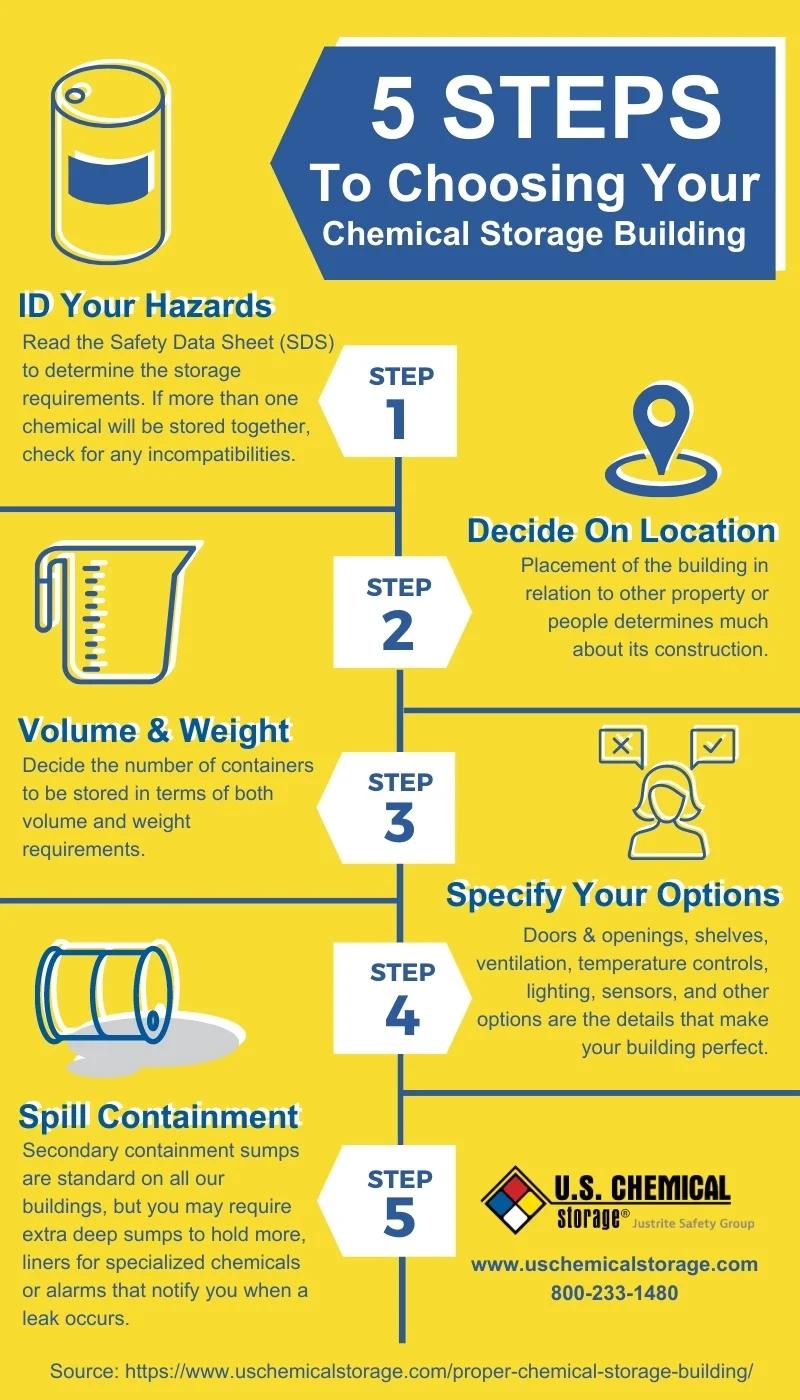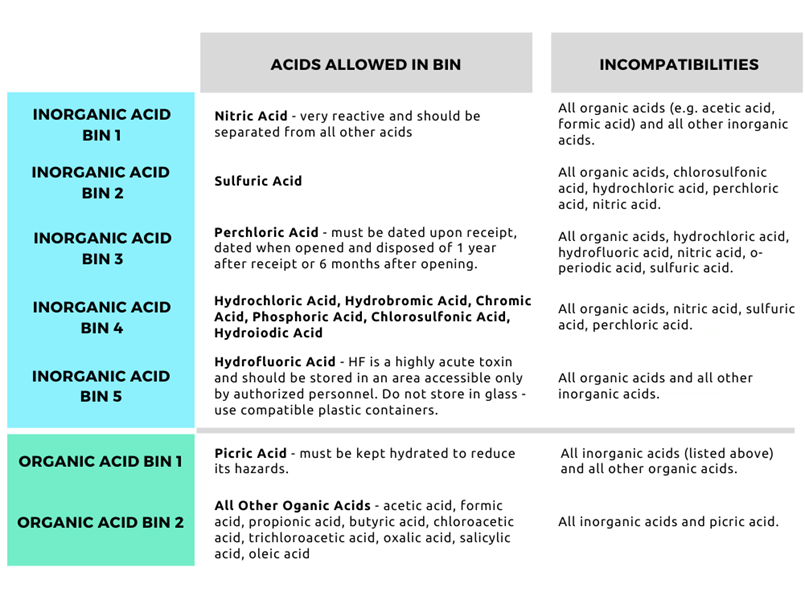Chemical Storage and Management
The following is a general guideline on how chemicals should be stored in a laboratory setting. Always consult the Lab Door Cards to identify incompatible materials and determine proper storage requirements.
General Rules for Chemical Storage
1. Do not store liquid chemicals above shoulder height.
2. Flammable chemicals in amounts exceeding 10 gallons must be stored in flammable storage cabinets or safety containers.
3. Only two 1 lb propane cylinders are allowed to be stored in the lab, with an additional two permitted in a flammable storage cabinet.
4. Bottles may not be stored on the floor unless they are contained in tubs or suitable secondary containment.
5. Excessive chemical storage in fume hoods is not acceptable, as it interferes with airflow and reduces the available workspace.
6. Chemical waste must be placed in the designated accumulation area, using appropriate receptacles that are properly labeled and segregated by hazard class.
7. Place waste requests for any chemicals that are older than 15 years.
8. Place waste requests for any chemicals that are in damaged chemical containers.

Solid or Powdered Chemical
Most solid chemicals can be organized on shelves in alphabetical order, with a few important exceptions:
1. Phenol Crystals: These must be stored separately from oxidizers.
2. Cyanide Compounds: These should never be stored near acids.
3. Flammable Solids: These should be kept separate from other solids or placed in Flammable Storage Cabinets.
4. Powdered Metals: Store these according to the instructions provided on the bottle label or Lab Door
Card.
Additionally, the storage requirements for certain metals may vary based on their packaging conditions (for example, if they are in a flammable solvent), which may necessitate storing them in flammable storage cabinets.
Liquid Chemicals Storage Guidelines
All liquid chemicals must be organized by hazard classification and stored only with compatible substances. The following categories of liquid chemicals should be kept separate from one another:
1. Acids: Organic acids should be stored separately from inorganic (mineral) acids. For example, acetic and formic acids should be kept away from hydrochloric and sulfuric acids. Note that not all inorganic acids are compatible; please refer to the acid compatibility guide for more information.
2. Bases: Bases can react violently with acids, oxidizers, or flammable substances.
3. Oxidizers: Oxidizers must be kept away from acids, bases, organic materials, and metals. They should be stored in a cool place. Examples of strong oxidizers include perchloric acid, nitric acid, and concentrated hydrogen peroxide.
4. Flammable Liquids: Limit the quantity of solvents present on benches or open shelving. A maximum of 10 gallons may be left out in the lab at any time.
5. Toxic or Poisonous Liquids: These should be segregated and stored separately, as they could become more hazardous when reacting with other chemicals. For example, cyanide solutions must be stored carefully. Other chemicals, such as formaldehyde, should be kept in plastic bottles and placed on the lowest shelf or storage space.
**Important Note**: Flammable liquids, acids, bases, and oxidizers must all be stored apart from each other due to their incompatibility.
Corrosive Chemicals
Corrosives consist of four major classes: acids, bases, dehydrating agents and oxidizing agents. Inhalation of the vapors of these substances can cause severe respiratory tract irritation. Contact with these chemicals may cause burns to the skin, respiratory tract and eyes.
Acids and Bases:
- Store chemicals separately in a cool, well-ventilated area, away from metals, flammable materials, and oxidizers.
- Use secondary containment, such as chemical-resistant tubs or bottle carriers, to isolate and protect bottles, especially during transportation.
- Regularly inspect the storage area for spills and leaks.
- Ensure that suitable spill clean-up materials are readily available.
- Always pour acids into water—never the reverse. Remember: “AAA – Always Add Acids.”
- Securely cap bottles, except in cases where mixtures may generate gases during storage. Examples include Aqua Regia, piranha solutions, and other highly corrosive mixtures. These should be stored in fume hoods or vented cabinets.

Flammable/Combustible Liquids
The storage of flammable materials must comply with the requirements set forth in NFPA 45 and Environmental Health & Safety (EHS) regulations and guidelines.
1. Quantity for Immediate Use: Only small quantities of flammable materials (500 ml or less) should be kept available for immediate use.
2. Storage for Larger Quantities: If your laboratory stores more than ten (10) gallons of flammable materials cumulatively, you must utilize safety cans or a flammable storage cabinet.
3. Approved Safety Containers: The best option for storing flammable liquids or waste solvents in small quantities is an approved safety can, which should have a self-closing cover, a vent, and a flame arrestor. Ordinary five-gallon containers do not provide adequate fire protection.
4. Storage of 55-Gallon Drums: The use of 55-gallon drums in laboratories is not permitted unless they are stored within flammable storage cabinets that have appropriate spill control and grounding. This must be approved in advance by EHS.
Flammable Storage Rated Refrigerators
Household refrigerators and freezers are not designed with electrical-safe controls and should never be used to store flammable liquids. Flammable storage refrigerators/freezers are specifically constructed with their controls mounted outside of the storage compartment. These units are suitable for storing flammable liquids and will be labeled accordingly by the manufacturer.
Oxidizers
This class of chemicals includes nitrates, permanganates, and oxides. These compounds pose fire and explosion hazards, particularly when they come into contact with organic materials and other oxidizing substances. Here are some safety guidelines for their use and storage:
- Storage: Keep oxidizing agents separate from flammable liquids, corrosives, organic materials, dehydrating agents, and reducing agents.
- Containers: Strong oxidizing agents should be stored and handled in glass or other inert containers. Avoid using corks and rubber stoppers.
- Usage: Exercise caution when using oxidizing agents in the vicinity of flammable materials.